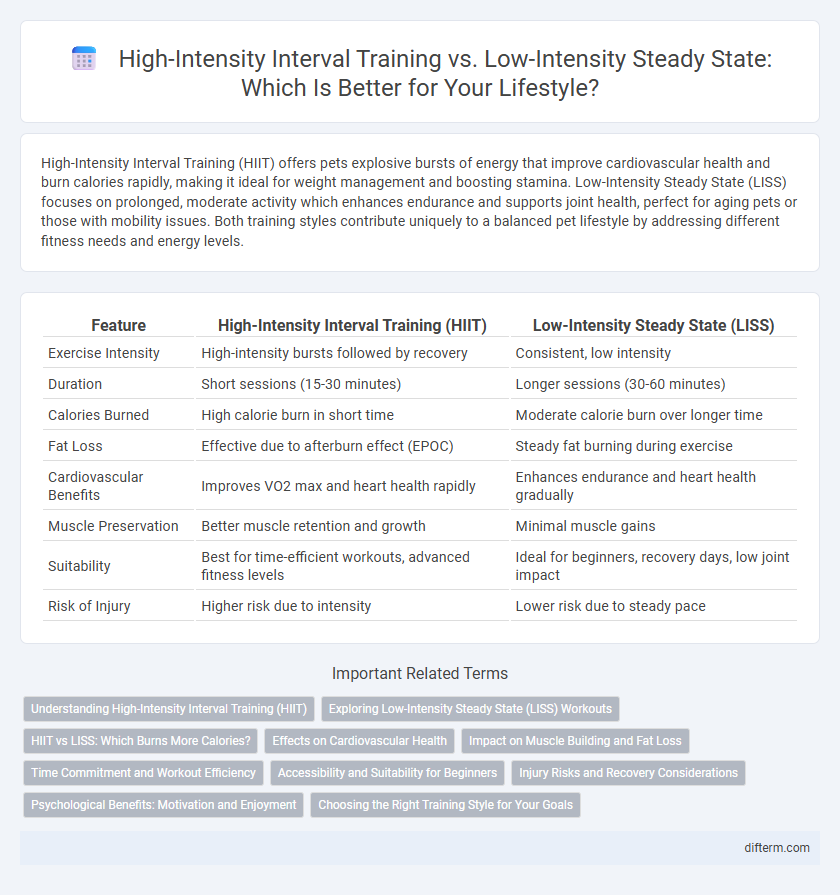High-Intensity Interval Training (HIIT) offers pets explosive bursts of energy that improve cardiovascular health and burn calories rapidly, making it ideal for weight management and boosting stamina. Low-Intensity Steady State (LISS) focuses on prolonged, moderate activity which enhances endurance and supports joint health, perfect for aging pets or those with mobility issues. Both training styles contribute uniquely to a balanced pet lifestyle by addressing different fitness needs and energy levels.
Table of Comparison
| Feature | High-Intensity Interval Training (HIIT) | Low-Intensity Steady State (LISS) |
|---|---|---|
| Exercise Intensity | High-intensity bursts followed by recovery | Consistent, low intensity |
| Duration | Short sessions (15-30 minutes) | Longer sessions (30-60 minutes) |
| Calories Burned | High calorie burn in short time | Moderate calorie burn over longer time |
| Fat Loss | Effective due to afterburn effect (EPOC) | Steady fat burning during exercise |
| Cardiovascular Benefits | Improves VO2 max and heart health rapidly | Enhances endurance and heart health gradually |
| Muscle Preservation | Better muscle retention and growth | Minimal muscle gains |
| Suitability | Best for time-efficient workouts, advanced fitness levels | Ideal for beginners, recovery days, low joint impact |
| Risk of Injury | Higher risk due to intensity | Lower risk due to steady pace |
Understanding High-Intensity Interval Training (HIIT)
High-Intensity Interval Training (HIIT) involves short bursts of intense exercise alternated with low-intensity recovery periods, maximizing calorie burn and improving cardiovascular fitness in less time compared to traditional workouts. Research shows HIIT can increase metabolic rate for hours post-exercise, promoting fat loss and muscle retention effectively. This training method suits individuals seeking efficient fat reduction and enhanced endurance through varied, time-efficient routines.
Exploring Low-Intensity Steady State (LISS) Workouts
Low-Intensity Steady State (LISS) workouts involve maintaining a consistent, moderate pace for an extended period, typically 30 to 60 minutes, enhancing fat oxidation and cardiovascular endurance. Unlike High-Intensity Interval Training (HIIT), LISS places less stress on joints and muscles, reducing injury risk while promoting recovery and long-term adherence. Popular LISS activities include brisk walking, cycling, and swimming, making it accessible for beginners and those seeking sustainable, low-impact exercise routines.
HIIT vs LISS: Which Burns More Calories?
High-Intensity Interval Training (HIIT) burns more calories in a shorter time compared to Low-Intensity Steady State (LISS) due to its intense bursts of activity that elevate heart rate and metabolism. HIIT also promotes greater excess post-exercise oxygen consumption (EPOC), resulting in continued calorie burn after workouts. In contrast, LISS maintains a consistent moderate pace, leading to fewer calories burned per session but is easier to sustain for longer durations.
Effects on Cardiovascular Health
High-Intensity Interval Training (HIIT) significantly improves cardiovascular health by increasing VO2 max and enhancing heart rate variability, leading to better heart function and endurance. Low-Intensity Steady State (LISS) exercise promotes cardiovascular benefits through sustained fat oxidation and improved circulation, making it suitable for maintaining heart health with lower injury risk. Both training methods contribute to reduced blood pressure and improved lipid profiles, yet HIIT offers more rapid cardiovascular adaptations in shorter workout durations.
Impact on Muscle Building and Fat Loss
High-Intensity Interval Training (HIIT) accelerates fat loss by boosting metabolism and stimulating muscle growth through intense, short bursts of activity that increase anabolic hormone levels. Low-Intensity Steady State (LISS) primarily enhances fat oxidation during extended workouts but has a less pronounced effect on muscle hypertrophy compared to HIIT. Incorporating HIIT can optimize body composition by promoting muscle retention and improving fat loss efficiency more effectively than LISS.
Time Commitment and Workout Efficiency
High-Intensity Interval Training (HIIT) maximizes workout efficiency by delivering intense bursts of exercise within 20-30 minutes, making it ideal for those with limited time. Low-Intensity Steady State (LISS) requires longer sessions, often 45-60 minutes, but is easier to sustain and promotes consistent calorie burn. Choosing between HIIT and LISS depends on individual time commitment preferences and fitness goals related to endurance and fat loss.
Accessibility and Suitability for Beginners
High-Intensity Interval Training (HIIT) offers effective calorie burn in shorter time frames but demands a higher fitness level, potentially challenging beginners or those with mobility issues. Low-Intensity Steady State (LISS) exercises, such as walking or light cycling, provide a more accessible and sustainable option ideal for beginners due to their lower impact and easier intensity management. Fitness experts recommend starting with LISS to build endurance and confidence before progressing to HIIT for enhanced cardiovascular benefits.
Injury Risks and Recovery Considerations
High-Intensity Interval Training (HIIT) carries a higher risk of injury due to its intense, explosive movements that place significant stress on muscles and joints, necessitating careful warm-up and proper form to prevent strains and sprains. In contrast, Low-Intensity Steady State (LISS) exercises, characterized by prolonged, moderate activity like walking or cycling, present a lower injury risk and promote steady cardiovascular benefits with less recovery time required. Recovery considerations for HIIT demand extended rest and muscle repair strategies, while LISS allows for more frequent sessions, supporting sustained activity without excessive fatigue.
Psychological Benefits: Motivation and Enjoyment
High-Intensity Interval Training (HIIT) significantly boosts motivation by offering varied and challenging exercises that prevent workout monotony. In contrast, Low-Intensity Steady State (LISS) promotes enjoyment through rhythmic, steady movements that encourage mindfulness and stress reduction. Both methods enhance psychological well-being, but HIIT tends to increase short-term motivation, while LISS supports sustained mental relaxation.
Choosing the Right Training Style for Your Goals
High-Intensity Interval Training (HIIT) maximizes calorie burn and improves cardiovascular fitness in shorter sessions, making it ideal for fat loss and time-efficient workouts. Low-Intensity Steady State (LISS) focuses on prolonged, consistent activity that enhances endurance and promotes fat oxidation, suited for building aerobic capacity and recovery days. Selecting between HIIT and LISS depends on individual goals, fitness levels, and time availability, with a combination often providing balanced benefits.
High-Intensity Interval Training vs Low-Intensity Steady State Infographic

 difterm.com
difterm.com